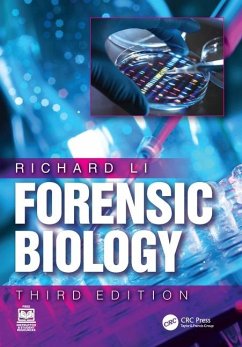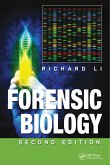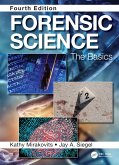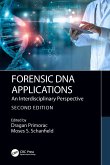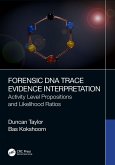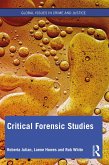Schade – dieser Artikel ist leider ausverkauft. Sobald wir wissen, ob und wann der Artikel wieder verfügbar ist, informieren wir Sie an dieser Stelle.
- Gebundenes Buch
- Merkliste
- Auf die Merkliste
- Bewerten Bewerten
- Teilen
- Produkt teilen
- Produkterinnerung
- Produkterinnerung
Forensic Biology, Third Edition provides students with a general understanding of forensic biology, particularly in forensic serology and forensic DNA analysis, and addresses rapid advancements in the field over the past few years.
Andere Kunden interessierten sich auch für
![Forensic Biology Forensic Biology]() Richard LiForensic Biology102,99 €
Richard LiForensic Biology102,99 €![Forensic Science Forensic Science]() Kathy Mirakovits (USA Portage Northern High School)Forensic Science127,99 €
Kathy Mirakovits (USA Portage Northern High School)Forensic Science127,99 €![Forensic DNA Applications Forensic DNA Applications]() Forensic DNA Applications88,99 €
Forensic DNA Applications88,99 €![Forensic DNA Trace Evidence Interpretation Forensic DNA Trace Evidence Interpretation]() Duncan Taylor (Forensic Science South Australia (FSSA) Australia )Forensic DNA Trace Evidence Interpretation108,99 €
Duncan Taylor (Forensic Science South Australia (FSSA) Australia )Forensic DNA Trace Evidence Interpretation108,99 €![Forensic DNA Transfer Forensic DNA Transfer]() Jane Moira TaupinForensic DNA Transfer152,99 €
Jane Moira TaupinForensic DNA Transfer152,99 €![Forensic DNA Transfer Forensic DNA Transfer]() Jane Moira TaupinForensic DNA Transfer55,99 €
Jane Moira TaupinForensic DNA Transfer55,99 €![Critical Forensic Studies Critical Forensic Studies]() Roberta JulianCritical Forensic Studies40,99 €
Roberta JulianCritical Forensic Studies40,99 €-
-
-
Forensic Biology, Third Edition provides students with a general understanding of forensic biology, particularly in forensic serology and forensic DNA analysis, and addresses rapid advancements in the field over the past few years.
Produktdetails
- Produktdetails
- Verlag: Taylor & Francis Ltd
- 3 ed
- Seitenzahl: 558
- Erscheinungstermin: 26. März 2025
- Englisch
- Abmessung: 261mm x 184mm x 35mm
- Gewicht: 1424g
- ISBN-13: 9781032913414
- ISBN-10: 103291341X
- Artikelnr.: 71777994
- Herstellerkennzeichnung
- Libri GmbH
- Europaallee 1
- 36244 Bad Hersfeld
- gpsr@libri.de
- Verlag: Taylor & Francis Ltd
- 3 ed
- Seitenzahl: 558
- Erscheinungstermin: 26. März 2025
- Englisch
- Abmessung: 261mm x 184mm x 35mm
- Gewicht: 1424g
- ISBN-13: 9781032913414
- ISBN-10: 103291341X
- Artikelnr.: 71777994
- Herstellerkennzeichnung
- Libri GmbH
- Europaallee 1
- 36244 Bad Hersfeld
- gpsr@libri.de
Richard Li earned his MS in forensic science from the University of New Haven and his Ph.D. in molecular biology from the University of Wisconsin-Madison. After completing his Ph.D., Dr. Li was awarded a postdoctoral fellowship at Weill Medical College of Cornell University and subsequently worked as a research faculty member at the School of Medicine of Yale University. Dr. Li has also served as a criminalist at the Department of Forensic Biology in the Office of Chief Medical Examiner of New York City. For the past several decades, he has held faculty positions in forensic science programs in the United States. Currently, Dr. Li is a faculty member at John Jay College of Criminal Justice and also serves as a faculty member for the Ph.D. program in criminal justice at the college. His research interests include identification and analysis of biological specimens that are potentially useful in forensic investigations.
SECTION I Biological Evidence
Chapter 1 Crime Scene Investigation of Biological Evidence
Chapter 2 Crime Scene Bloodstain Pattern Analysis
Chapter 3 Forensic Biology: A Subdiscipline of Forensic Science
Chapter 4 Sources of Biological Evidence
SECTION II Basic Techniques in Forensic Biology
Chapter 5 Nucleic Acid Extraction
Chapter 6 DNA Quantification
Chapter 7 Nucleic Acid Amplification
Chapter 8 Basic Techniques for Length Polymorphism Analysis
Chapter 9 Basic Techniques for Sequence Polymorphism Analysis
Chapter 10 Serology Concepts
Chapter 11 Forensic Serology Techniques
Chapter 12 Emerging Body Fluid Identification Techniques
SECTION III Identification of Biological Evidence
Chapter 13 Identification of Blood
Chapter 14 Identification of Semen
Chapter 15 Identification of Saliva
Chapter 16 Identification of Vaginal Secretions and Menstrual Blood
Chapter 17 Identification of Other Body Fluids and Cellular Materials
SECTION IV Individualization of Biological Evidence
Chapter 18 Blood Group Typing and Protein Profiling
Chapter 19 Variable Number Tandem Repeat Profiling
Chapter 20 Autosomal Short Tandem Repeat Profiling
Chapter 21 Sex Chromosome Haplotyping and Identification
Chapter 22 Single Nucleotide Polymorphism Profiling
Chapter 23 Mitochondrial DNA Profiling
SECTION V Forensic Issues
Chapter 24 Forensic DNA Databases: Tools for Crime Investigations
Chapter 25 Evaluation of the Strength of Forensic DNA Profiling Results
Chapter 26 Standards and Qualifications
Chapter 1 Crime Scene Investigation of Biological Evidence
Chapter 2 Crime Scene Bloodstain Pattern Analysis
Chapter 3 Forensic Biology: A Subdiscipline of Forensic Science
Chapter 4 Sources of Biological Evidence
SECTION II Basic Techniques in Forensic Biology
Chapter 5 Nucleic Acid Extraction
Chapter 6 DNA Quantification
Chapter 7 Nucleic Acid Amplification
Chapter 8 Basic Techniques for Length Polymorphism Analysis
Chapter 9 Basic Techniques for Sequence Polymorphism Analysis
Chapter 10 Serology Concepts
Chapter 11 Forensic Serology Techniques
Chapter 12 Emerging Body Fluid Identification Techniques
SECTION III Identification of Biological Evidence
Chapter 13 Identification of Blood
Chapter 14 Identification of Semen
Chapter 15 Identification of Saliva
Chapter 16 Identification of Vaginal Secretions and Menstrual Blood
Chapter 17 Identification of Other Body Fluids and Cellular Materials
SECTION IV Individualization of Biological Evidence
Chapter 18 Blood Group Typing and Protein Profiling
Chapter 19 Variable Number Tandem Repeat Profiling
Chapter 20 Autosomal Short Tandem Repeat Profiling
Chapter 21 Sex Chromosome Haplotyping and Identification
Chapter 22 Single Nucleotide Polymorphism Profiling
Chapter 23 Mitochondrial DNA Profiling
SECTION V Forensic Issues
Chapter 24 Forensic DNA Databases: Tools for Crime Investigations
Chapter 25 Evaluation of the Strength of Forensic DNA Profiling Results
Chapter 26 Standards and Qualifications
SECTION I Biological Evidence
Chapter 1 Crime Scene Investigation of Biological Evidence
Chapter 2 Crime Scene Bloodstain Pattern Analysis
Chapter 3 Forensic Biology: A Subdiscipline of Forensic Science
Chapter 4 Sources of Biological Evidence
SECTION II Basic Techniques in Forensic Biology
Chapter 5 Nucleic Acid Extraction
Chapter 6 DNA Quantification
Chapter 7 Nucleic Acid Amplification
Chapter 8 Basic Techniques for Length Polymorphism Analysis
Chapter 9 Basic Techniques for Sequence Polymorphism Analysis
Chapter 10 Serology Concepts
Chapter 11 Forensic Serology Techniques
Chapter 12 Emerging Body Fluid Identification Techniques
SECTION III Identification of Biological Evidence
Chapter 13 Identification of Blood
Chapter 14 Identification of Semen
Chapter 15 Identification of Saliva
Chapter 16 Identification of Vaginal Secretions and Menstrual Blood
Chapter 17 Identification of Other Body Fluids and Cellular Materials
SECTION IV Individualization of Biological Evidence
Chapter 18 Blood Group Typing and Protein Profiling
Chapter 19 Variable Number Tandem Repeat Profiling
Chapter 20 Autosomal Short Tandem Repeat Profiling
Chapter 21 Sex Chromosome Haplotyping and Identification
Chapter 22 Single Nucleotide Polymorphism Profiling
Chapter 23 Mitochondrial DNA Profiling
SECTION V Forensic Issues
Chapter 24 Forensic DNA Databases: Tools for Crime Investigations
Chapter 25 Evaluation of the Strength of Forensic DNA Profiling Results
Chapter 26 Standards and Qualifications
Chapter 1 Crime Scene Investigation of Biological Evidence
Chapter 2 Crime Scene Bloodstain Pattern Analysis
Chapter 3 Forensic Biology: A Subdiscipline of Forensic Science
Chapter 4 Sources of Biological Evidence
SECTION II Basic Techniques in Forensic Biology
Chapter 5 Nucleic Acid Extraction
Chapter 6 DNA Quantification
Chapter 7 Nucleic Acid Amplification
Chapter 8 Basic Techniques for Length Polymorphism Analysis
Chapter 9 Basic Techniques for Sequence Polymorphism Analysis
Chapter 10 Serology Concepts
Chapter 11 Forensic Serology Techniques
Chapter 12 Emerging Body Fluid Identification Techniques
SECTION III Identification of Biological Evidence
Chapter 13 Identification of Blood
Chapter 14 Identification of Semen
Chapter 15 Identification of Saliva
Chapter 16 Identification of Vaginal Secretions and Menstrual Blood
Chapter 17 Identification of Other Body Fluids and Cellular Materials
SECTION IV Individualization of Biological Evidence
Chapter 18 Blood Group Typing and Protein Profiling
Chapter 19 Variable Number Tandem Repeat Profiling
Chapter 20 Autosomal Short Tandem Repeat Profiling
Chapter 21 Sex Chromosome Haplotyping and Identification
Chapter 22 Single Nucleotide Polymorphism Profiling
Chapter 23 Mitochondrial DNA Profiling
SECTION V Forensic Issues
Chapter 24 Forensic DNA Databases: Tools for Crime Investigations
Chapter 25 Evaluation of the Strength of Forensic DNA Profiling Results
Chapter 26 Standards and Qualifications

